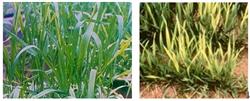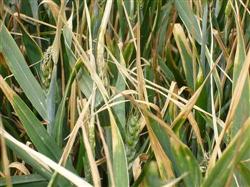Comprehensive control methods of wheat take-all disease

Wheat total erosion disease is a typical root disease, which can be infected from sowing to harvest. The main site of the disease was in the root of wheat and the 1-Murray 2 node at the base of the stem. After infection, the roots blackened and rotted, lost the ability to absorb water and nutrients, and caused the aboveground parts to dry up and die, resulting in white ears. First, the field performance: the symptom of the disease was not obvious in the wheat seedling stage, but obvious in the filling stage. The aboveground wheat died in clusters or patches. When the diseased plant is pulled out, the root system is short and few, blackened and rotten, the leaf sheath of 1 Mel 2 node at the base of the stem is stripped off, and there is a black plaster-like and invented mycelium layer on the stem. Small black spots, namely ascomycetes, can be seen on the leaf sheath when the field climate is humid. During drought, the root system blackened, and the mycelium and ascomycetes could not be formed. Second, the route of transmission: the infected remains are transmitted through seeds, soil and manure. Third, infection cycle: in addition to infection damage to wheat, Gramineae crops such as corn, millet and Gramineae weeds can be infected, but do not show symptoms. After wheat harvest, the pathogen oversummered on the diseased remains or other gramineous plants, and infected the wheat after sowing. Fourth, disease conditions: continuous cropping land is heavy, rotation is light; low fertility land is heavy, high fertility land is light; fifth, prevention and control methods: prevention and control of this disease is more important than treatment, monitoring should be strengthened and epidemic survey should be carried out. 1. Agricultural prevention and control: (1) removal of disease and residue and incineration. Reduce and alleviate pathogens. (2) reasonable rotation. Rotation with non-host crops. (3) the appropriate time for late sowing. The soil temperature dropped below 12 ℃, which was not conducive to the invasion of bacteria. (4) increase the application of organic fertilizer, phosphorus and potassium fertilizer. two。 Chemical control: (1) soil treatment. Use 2.5 kg carbendazim or methyl topiramate per mu, 15 kg mixed with soil, spread before ploughing, and sprinkle more in seriously ill areas. (2) seed treatment. Coat or mix seeds with agents for the prevention and treatment of total erosion. The potions are: Diweidan, Shilushi, Likeatraz. (3) Prevention and control in early spring. The root irrigation control of wheat was carried out with Heguoli or strychnine before jointing.
- Prev

Control methods of Wet damage to Wheat
The symptoms of boron deficiency in wheat generally appear first in the new tissue, showing that the terminal bud is easy to die, the flowering duration is long, sometimes tillering while heading, the growth period is prolonged, the stamen is dysplastic, the anther is thin, the empty chaff does not crack, does not disperse the powder, the pollen is few or deformed, the ovary expands transversely, the glume does not close before and after, and wilts in the later stage.
- Next

Pay attention to the occurrence of diseases and insect pests in wheat seedling stage
In recent years, the symptoms of withered spike often occur in some plots of wheat at milk stage, which has a great influence on the yield and quality of wheat. The main causes of wheat white spike are diseases and insect pests, such as sheath blight, root rot, total erosion, scab, wheat stem fly, wheat stem moth, golden needle worm and so on. Caused by different diseases and pests.
Related
- The first cup of black tea in spring, the flavor and history of tea gardens in Kenya, Africa
- The computer can not only choose potatoes, but also grow tea rice. AI will grow winter oolong tea champion.
- It is not only the inflated tea bitten by insects, but also engraved with the four seasons tea in Beipu.
- The Oriental Beauty Tea Festival in Zhuxian County takes the stage at the weekend to experience the plus-size feast of oil tea.
- & quot; Oriental Beauty Tea & Exploration of Emei in Hsinchu, the hometown of quot;
- The new variety of strawberry "Tainong 1" dessert is the first choice with mellow aroma. Crimson gorgeous
- History of Tea in Taiwan: from Wild Inner Mountain to Export Tea Garden
- Two types of Taiwan Oriental Beauty Black Tea won the British three-Star Award for Childhood Tea Xiang Zhang Jiaqi changed from pilot to champion tea maker.
- Banana species and varieties: the planting history of Taiwan Xianren banana and dwarf banana is long, is banana disease resistant?
- Coffee planting Technology: Qianjie Coffee from Seedling to harvesting

